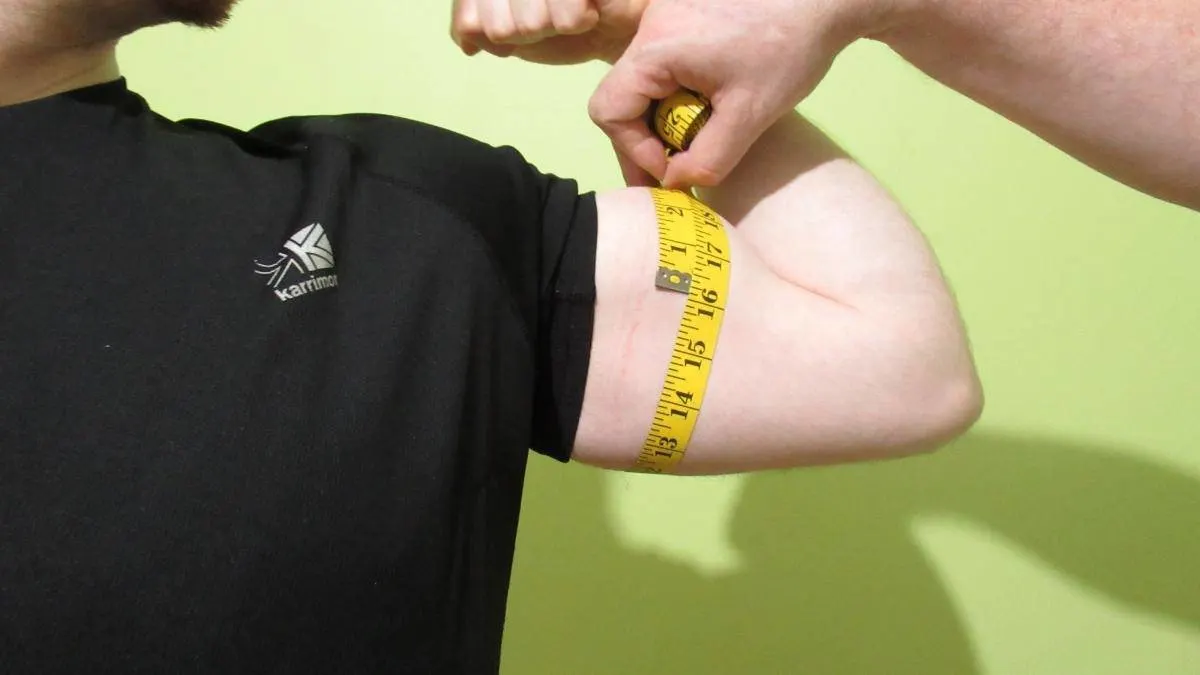Are 16 inch biceps big for a natural lifter? Or are 16 inch arms just an average bicep size for people who go to the gym?
Using 3 case studies and actual bicep size research, this 16 inch arm guide reveals how impressive 16 and 16.5 inch biceps really are.
We’ve taken into account a variety of factors, including height and body fat level, to determine whether building 16″ arms is attainable and, if so, how big such an arm size will actually look on your physique.
You’ll also learn how to get 16 inch arms as a natural lifter if you don’t already have them.
See How You Stack Up:
Are 16 inch biceps big?

Are 16 inch arms big?
First and foremost, it’s crucial to clarify that we’re talking about having 16 inch arms flexed, not relaxed.
In general, any arm size over the 16 inch mark is considered big for a natural lifter who has an average build, decent genetics, and a relatively low body fat level.
If you’re pretty short, let’s say 5’8″ or under, then a 16 inch bicep circumference will look much more impressive on your physique than that of someone who’s 6’4″.
While taller people usually have bigger arms in terms of measurement, they also need to build their biceps to a much larger size for them to stand out.
This is because taller lifters have longer limbs and therefore longer muscle bellies, which require more mass than shorter muscle bellies in order to look big and muscular.
Similarly, if you have 16 inch biceps flexed but also have a body fat percentage over 20%, then your arms will look less impressive than someone with 15 inch arms but only 12% body fat (indeed, it’s possible to have more muscular biceps than someone while still registering a smaller measurement than them due to that person having excess body fat).
How impressive are 16.5 inch biceps?
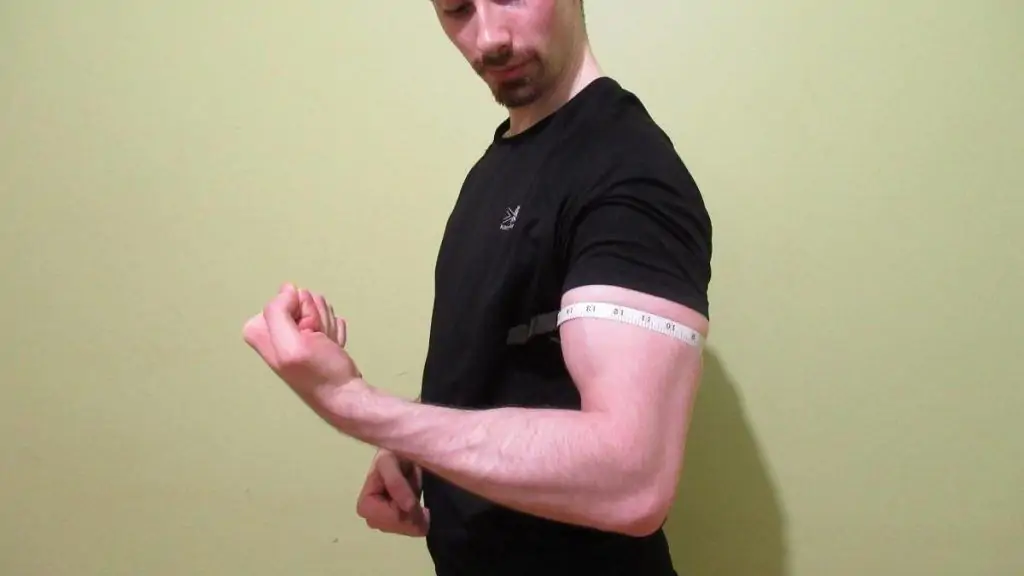
Going from 16″ arms to 16.5 inch arms (42 cm biceps) takes longer than most people think (this is so for a few reasons). And anyway, you need to get 16.25 inch biceps first!
First off, lean 16 in biceps are already big for most people who lift. Adding another half-inch of mostly muscle when you’re already strong and closing in on your genetic limitations is highly challenging.
Second, people often kid themselves into thinking that they’re making biceps gains when in reality, their new “muscle mass” is often an ugly combination of body fat and water weight.
Another way that they do this is by measuring their arms pumped in order to inflate the measurement and give themselves a nice ego boost.
On the other hand, if you already have 16.5 inch arms that look relativity lean (and if you aren’t ridiculously tall), then you can pat yourself on the back because that’s a very impressive size indeed.
16 inch bicep case studies
These three eye-opening 16 in bicep case studies will help you discern whether you have the genetics to achieve aesthetic 16 inch arms as a natural lifter.
You’ll also get a visual insight into how a person’s height affects the appearance of their biceps. As you’re about to find out, when a tall person and a short person both have 16 in arms, the shorter lifter’s biceps will always look far more impressive.
Case study 1: EatRightGuy
Germaine Guy is a registered dietitian and operates the YouTube channel EatRightGuy. He’s 5’6″ and has very impressive-looking 16″ biceps.
As you can see in the video, his arms look much bigger than 16 inches, even though they apparently weren’t as cut as they usually are.
Even though that may be the case, he clearly isn’t storing much body fat on his arms at all. This leanness is one reason why the individual heads of his triceps stand out so well.
In summary, this man’s arms have an enviable combination of size and definition, a combination that will require years of direct training for 99% of gym-goers to achieve.
Now contrast this with the next pair of 16 in biceps that you’re about to see.
Case study 2: The Real PBJ
The young man who operates the YouTube channel The Real PBJ is 6’1″ and, at the time of writing, has 16 inch biceps.
To understand just how much your height and limb length affects the appearance of your arms, let’s contrast the biceps of The Real PBJ with those of EatRightGuy.
Both men have 16 inch biceps flexed, verified by tape measure.
However, as anyone who watched both videos is forced to conclude, EatRightGuy’s arms look considerably bigger than The Real PBJ’s arms.
This is not to say that the young fella’s biceps aren’t impressive because they most certainly are.
Rather, the difference in the appearance of these two pairs of biceps (even though they’re the same size) proves that taller people need to bulk their biceps to a higher circumference measurement in order to rival the perceived size of people who are shorter.
It’s highly likely that over the course of time, The Real PBJ will actually surpass EatRightGuy in terms of measurement because he has a bigger bone structure (whether his arms will ever look bigger remains to be seen). [1]
In the same way that a longer clothesline provides more room to hang clothes, having more bone mass gives you more space to “hang” potential muscle.
Case study 3: Ross Newham
Ross Newham is a 6-foot natural bodybuilder and online coach with a very informative YouTube channel that bears his own name.
Although his arms are bigger than 16 inches, his excellent 2015 video gives some great insights into what it takes to achieve 16 inch biceps (41 cm biceps) as a natural lifter.
Newham notes that direct arm training is absolutely essential for the vast majority of people to build 16 inch arms because your biceps and triceps are not usually the limiting factor in compound movements.
As he admits in the comments section of the video, you could probably get 16 in arms without isolating them if you got very strong on your compound lifts.
However, this compound-only approach is extremely inefficient. You can achieve 16 and even 16.5 inch biceps much quicker by performing direct arm training twice per week.
He also highlights the importance of training your arms when they’re fresh so that you can put as much heavy tension through them as possible. In practice, this usually means having a separate arm day in addition to your chest/tricep and back/bicep sessions.
How to get 16 inch arms naturally
If you want to get 16 inch arms flexed, then make sure to implement these proven tricep and bicep-building tips into your bodybuilding training.
Perform plenty of direct training
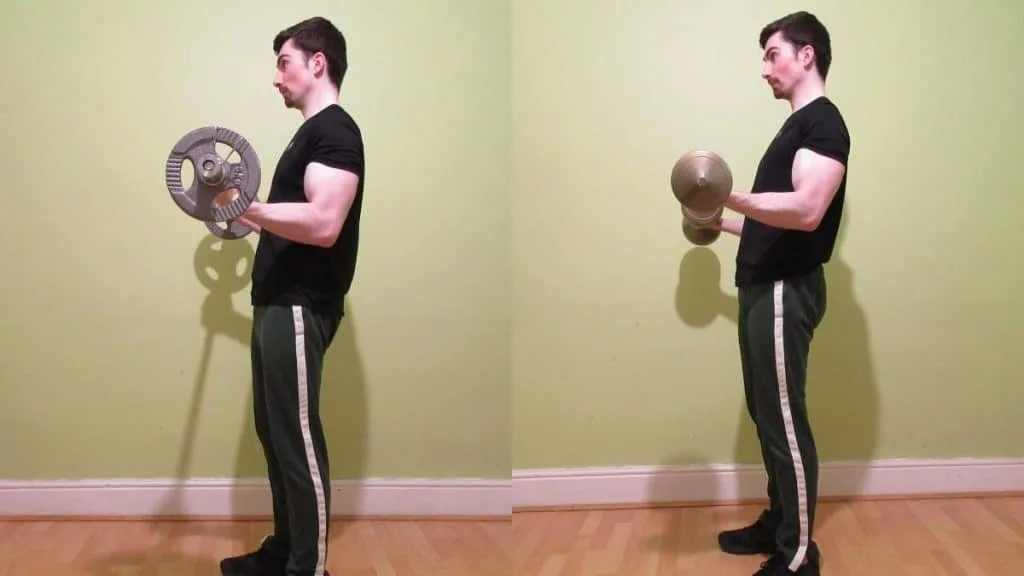
As mentioned, direct arm training is an absolute necessity for most natural lifters to achieve a lean 16 inch bicep measurement.
Sure, chin-ups and rows enable you to lift heavier weights than curls. But that doesn’t necessarily mean that your biceps are receiving more tension or doing any extra work.
In fact, during compound movements, the tension is divided across so many muscle groups (lats, traps, rear delts, etc.) that your biceps don’t actually get that much stimulation unless you do a lot of sets with an underhand grip.
You need to ensure that your biceps and triceps are the limiting factors in at least one exercise if you want to get anywhere near to maximizing your upper arm potential.
Improve your bicep peak and tricep long head
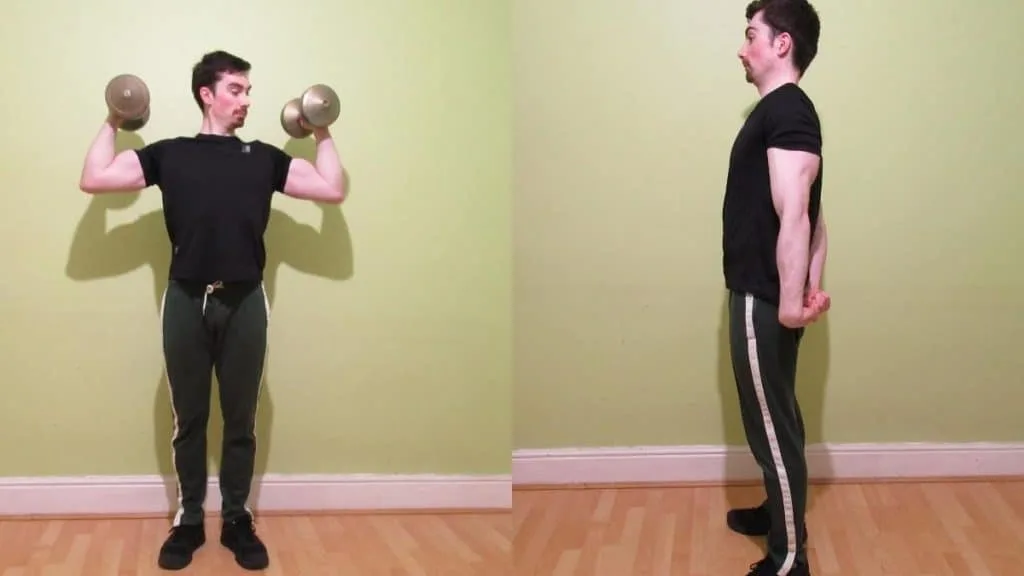
Those with a bigger, taller bicep peak will record a larger arm measurement (and have more impressive-looking flexed biceps) than those with longer, flatter biceps.
Of course, the shape of your biceps is largely genetic.
However, in addition to building overall mass, developing the long (outer) head of your biceps and your growing brachialis are the two next best ways to get 16″ arms.
Building your brachialis can actually help to push your biceps out and make them look more peaked. This is because the brachialis is a deep muscle that lies beneath the biceps brachii.
Similarly, developing the long head of your triceps should be your primary arm-building goal if you want to get 16 inch biceps flexed.
You probably know that the triceps account for two-thirds of your upper arm size, and you may even know that the long head is the biggest head of the triceps.
Yet many people don’t realize just how much growth potential the long head has. Some strength coaches estimate that the long head accounts for around two-thirds of your triceps mass, making it the single biggest upper arm muscle.
So don’t skimp on skull crushers and overhead extensions if you want to get 16 or 16.5 inch arms.
Eat in a calorie surplus and increase your protein intake

Although many dedicated natural lifters already consume sufficient protein and eat in a calorie surplus when bulking, a lot of gym-goers dismiss diet as inferior to training when it comes to building 16″ biceps.
While it’s true that lifting weights provides the main stimulus for hypertrophy, it’s the amino acids that actually get your muscles growing.
Getting enough protein ensures that your body spends more time in a state of muscle protein synthesis (MPS)—which causes muscle tissue to grow—and less time in a state of protein breakdown, which, although natural and perhaps even necessary, leads to muscle atrophy if it’s not tempered with enough prolonged periods of MPS. [2]
Similarly, eating in a moderate calorie surplus can often make you feel stronger in the gym and give you the capacity to perform more training volume, something that’s essential for hypertrophy.
Crucially, an energy surplus also gives your body an excess of energy that it can use to create new muscle tissue.
16 in bicep FAQ
Many gym-goers are curious whether or not 16 inch arms are impressive for their particular height.
So, in addition to answering various other questions, we’ve discussed how achievable and impressive 16 inch biceps are in a variety of different scenarios.
Are 16 in arms good at 5’8?
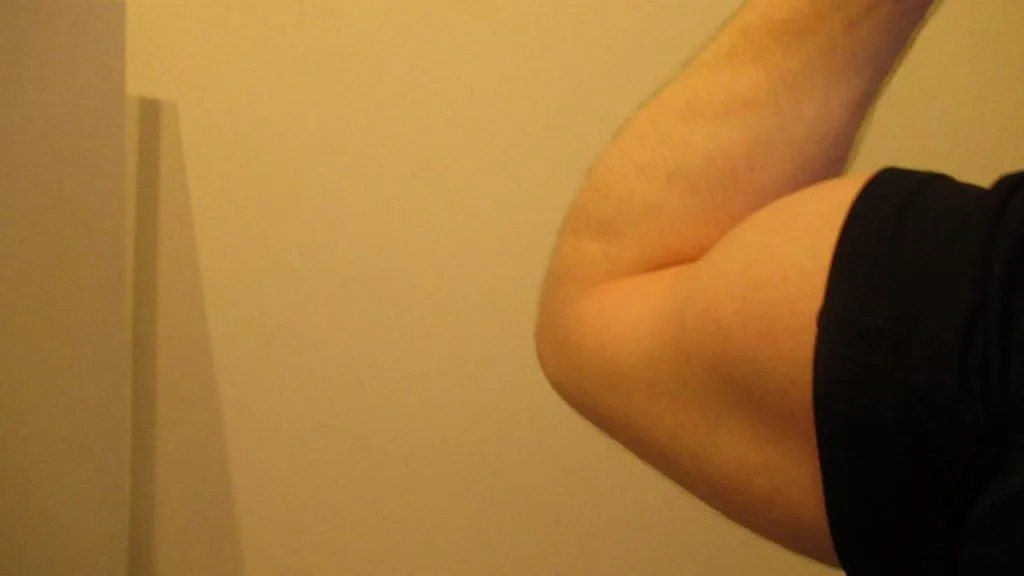
Are 16 inch arms good for someone who’s 5’8″?
Yes, lean, flexed 16 inch arms are very impressive for a man who is 5’8″.
People who are shorter have less bone mass than those who are taller and hence less capacity to achieve big absolute arm sizes.
So given an equivalent measurement, the shorter man will always look like he has bigger arms than the taller man because his arms are more filled out and developed (at 16 inches, the tall guy, unlike the short guy, still has quite a bit of mass left to gain).
Are 16 inch arms good at 5’10?
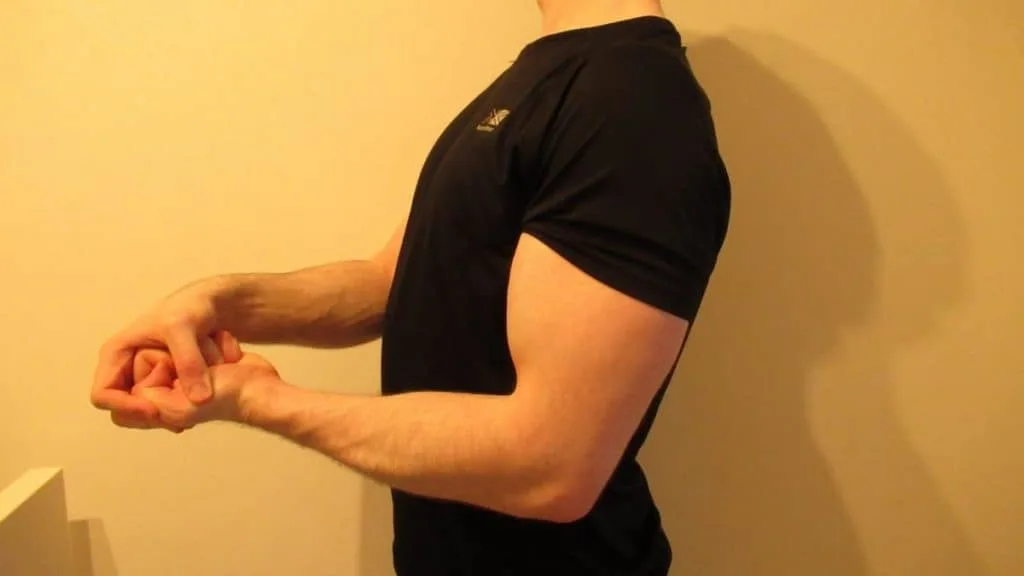
Are 16 inch arms big for a guy who is 5’10”?
Yes, if you have lean 16 inch biceps at a height of 5’10”, then you can definitely claim that you have big, muscular arms.
Considering the fact that 5’10” is a relatively normal height in many parts of the world and the widely-held belief that 16″ arms are impressive, you can count yourself as above average if you have 16 or 16.5 inch biceps at 5’10”.
Of course, if you’re above 20% body fat, then your 16 in biceps won’t look as impressive as if you were 12% body fat because they’ll have less definition and separation.
How impressive are 16 in biceps at 6 foot?

If you’re 6 feet tall (183 cm), then you’re definitely taller than average. But are 16 inch biceps big for people 6 foot and taller?
It depends.
If your body fat is high, then your 16″ arms might not actually look like they’re 16 inches because they’ll lack definition and vascularity.
On the other hand, if you’re around 15% body fat or lower, then the same arm size will likely look much more impressive because you’ll have a lot more separation between your muscles.
Of course, if you’re well over 6 feet tall, then you can still have 16 inch biceps that look toned and impressive, but they’re unlikely to look big or like those of a competitive bodybuilder (who tend to be well under 6 foot).
Should you take the measurement flexed or unflexed?
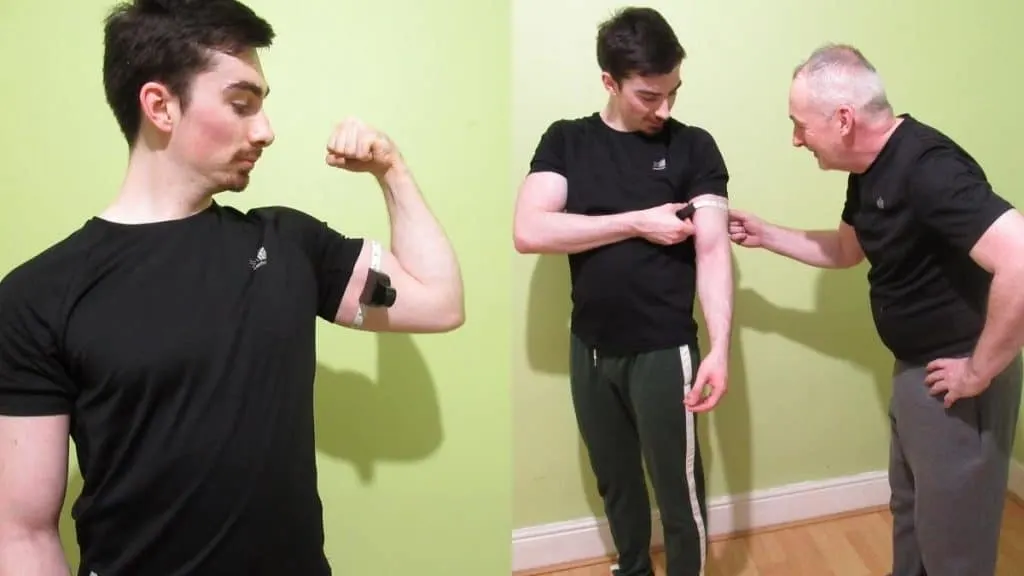
Most of the time, you should take your measurements flexed.
This is because your biceps can’t display their full muscularity when your arms are just hanging by your sides.
You can, of course, take a flexed and unflexed measurement in order to compare the difference (a 2 inch difference is typical).
However, if you want to track your muscle growth progress and use your arm size as a point of comparison, always take a flexed measurement.
Is it possible to get 16″ biceps without isolating them?

Yes, in theory, you can get 16 or 16.5 inch arms without performing any isolation work.
If you’re very tall, then getting 16 in biceps without any direct training is actually quite easy because a 16 in bicep circumference isn’t actually that big for someone 6’3″ or more.
For people of average height, however, getting 16 in arms without direct training is challenging.
You’d need to do plenty of underhand pulling exercises and lots of heavy compound pressing.
So while it’s not the most efficient way to achieve a 16 inch arm measurement, compound-only training can work in the long run if you combine it with an appropriate diet.
After all, your biceps and triceps don’t know what “curls” and “extensions” are; they just respond to tension.
I have 16 inch biceps, but they look small. Why is this?
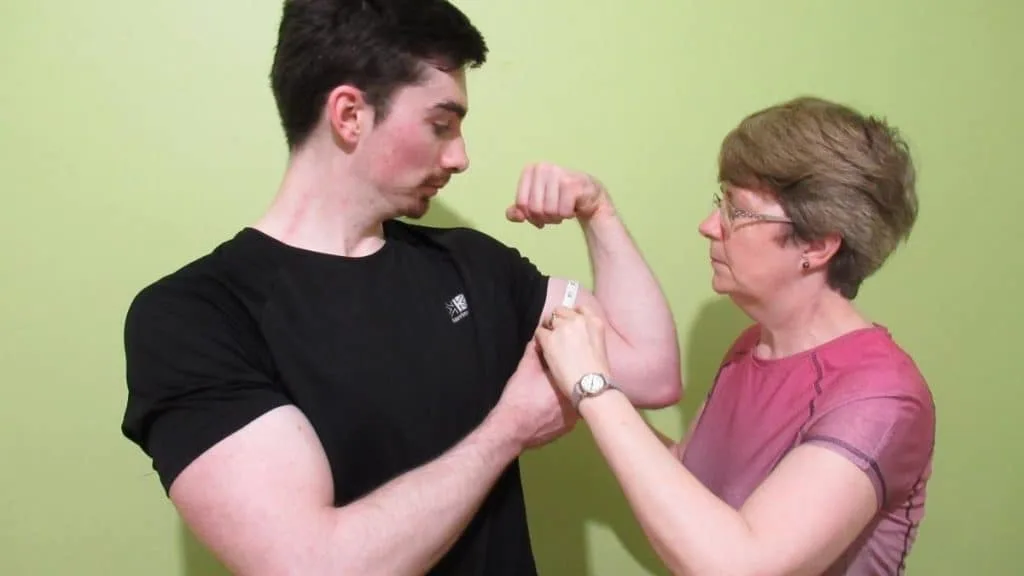
If you have 16 inch biceps that look small, then it could be for one of three reasons.
First off, if you have excess body fat that obscures your arm definition, then your biceps won’t look impressive even if they’re genuinely muscular.
Second, if you’re well over 6 feet, then you’re going to need more than 16 inches in the arm department to turn heads in the street.
As mentioned, taller people typically have a harder time filling their arms out but can generally build bigger biceps overall due to having longer bones and muscle bellies.
Finally, you might have an unaesthetic biceps shape. If your biceps are long and flat, then they might look good when your arms are relaxed. However, if you don’t have a good peak, then your biceps might look smaller than they actually are when you flex them.
The verdict: Is having 16″ arms impressive for a natural lifter?

In summary, having 16 inch arms as a natural lifter is very impressive about 80% of the time.
The exceptions to this are people with an excessively high body fat level and those who happen to be very tall.
In the first instance, the body fat will cover your muscle mass, and in the second case, your arms won’t look very filled out or well-developed due to your height.
Building 16 inch biceps generally requires twice-weekly direct training and plenty of patience.
Many gym-goers perform endless amounts of arm training and still don’t have 16″ arms. So if you’re in the 16 inch club, then you can definitely be proud of your achievement.
Just don’t underestimate the challenge of getting to 16.5 inch biceps as a natural lifter; half an inch of growth is a lot when your arms are already well-developed.
References
- Chumlea, W. C., Wisemandle, W., Guo, S. S., & Siervogel, R. M. (2002b). Relations between frame size and body composition and bone mineral status. The American Journal of Clinical Nutrition, 75(6), 1012–1016. https://doi.org/10.1093/ajcn/75.6.1012
- Tipton, K. D., Hamilton, D. L., & Gallagher, I. J. (2018). Assessing the Role of Muscle Protein Breakdown in Response to Nutrition and Exercise in Humans. Sports Medicine, 48(S1), 53–64. https://doi.org/10.1007/s40279-017-0845-5

